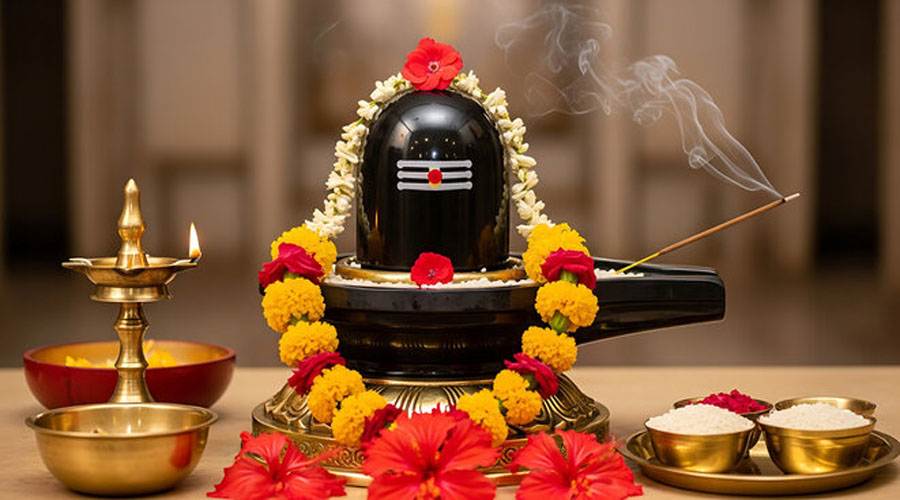Among the infinite symbols that express the divine in Hinduism, the Shiva Linga holds a central, timeless position. It embodies Lord Shiva’s boundless power, representing both creation and destruction — the cyclical rhythm of the universe itself. Sacred, enigmatic, and beyond form or gender, the Shiva Linga transcends human understanding, inviting seekers to experience the absolute reality that lies beyond name, shape, and belief.
Origin and Meaning of the Shiva Linga
The word Linga is derived from the Sanskrit root ling, meaning “mark,” “symbol,” or “sign.” In the sacred texts, Linga is referred to as a sign of the Supreme Being — a representation of the invisible cosmic energy manifesting as all forms of life. The ancient scripture Linga Purana describes it as the formless symbol of the unborn, eternal essence, the energy that creates, sustains, and dissolves the universe.
According to Hindu tradition, the Shiva Linga is not merely a representation of Lord Shiva but the symbol of the infinite Brahman, the unmanifest consciousness. It goes beyond anthropomorphic depictions, urging devotees to see divinity in its purest, formless state.
Mythological Origins: The Pillar of Fire
One of the most symbolic legends explaining the origin of the Linga is found in the Shiva Purana. In this cosmic tale, Lord Vishnu and Lord Brahma disputed over who was the supreme creator. Suddenly, a vast pillar of fire — the Jyotirlinga — appeared before them, endless in both directions. Brahma flew upward to find its top, while Vishnu burrowed downward to find its base. After ages of searching, neither could reach its end.
At that moment, Lord Shiva emerged from the pillar, revealing Himself as the infinite power that transcends both creation and preservation. This pillar of light became the symbolic representation of the Shiva Linga — a mark of infinite divinity that has no beginning or end.
Philosophical Significance: The Union of Shiva and Shakti
The Shiva Linga is not merely a representation of masculine energy. In its complete form, it comprises two fundamental aspects of existence — Shiva (the consciousness) and Shakti (the creative force). The circular base, known as the Yoni, symbolizes Shakti, the feminine principle, while the upright oval structure represents Shiva, the masculine energy.
Together, they embody the inseparable union of male and female energies — the eternal dance of creation. This union signifies that all existence arises from the interplay of these cosmic forces, mirroring the concept of Ardhanarishvara, where Shiva and Parvati exist as one.
Thus, worshipping the Linga is not an act of idol worship but a recognition of the cosmic balance and unity inherent in the universe.
Symbolism in Sacred Geometry and Energy
The Shiva Linga also reflects profound yogic and tantric symbolism. Its oval shape resembles a cosmic egg or Brahmanda — the source of all creation. In yogic philosophy, the Linga represents the inner linga sharira or the subtle body, where the kundalini shakti (inner energy) resides at the base of the spine.
When awakened through meditation or spiritual practice, this energy ascends toward the crown of the head — symbolically merging with Shiva or pure consciousness. Hence, the Linga becomes both a cosmic map and an inner meditative device to connect the devotee with universal consciousness.
Many temples in India align their Shiva Lingas with precise geomagnetic and energetic principles. This alignment enhances spiritual vibrations, purifying the body and mind of those who meditate or pray nearby.
Historical and Cultural Evolution
The worship of the Shiva Linga dates back to the Indus Valley Civilization (circa 2500 BCE). Excavations at Harappa and Mohenjo-Daro have revealed stone and terracotta objects resembling Lingas and Yonis, suggesting that the roots of this worship predate classical Hinduism.
Over millennia, the Linga evolved into various forms across India:
- Jyotirlingas: These are twelve sacred shrines where Lord Shiva is believed to have manifested as pillars of light. They include Somnath, Kedarnath, Kashi Vishwanath, and others.
- Banalinga: Smooth, naturally-formed stones found in the Narmada River, considered self-manifested symbols of Shiva.
- Mukhalingas: Sculpted Lingas that feature one or more faces of Lord Shiva, representing His human aspect.
- Spatika Linga: Made from quartz crystal, believed to embody purity and amplify positive energy.
Each form of the Linga represents a unique aspect of Shiva’s cosmic role, connecting devotees across ages and geographies.
Rituals and Forms of Worship
The ritual of Abhishekam — the ceremonial bathing of the Linga — holds immense significance in Shaivite practice. Devotees pour water, milk, honey, ghee, and sometimes medicinal herbs over the Linga, accompanied by the chanting of sacred mantras.
Each offering carries symbolic meaning:
- Water – Purifies the mind and spirit
- Milk – Represents spiritual nourishment and devotion
- Honey – Signifies sweetness and love
- Bhasma (ash) – Denotes detachment from material life
Together, these offerings represent the surrender of the ego and the renewal of spiritual consciousness.
During festivals like Maha Shivaratri, millions of devotees fast and offer prayers to the Shiva Linga throughout the night, believing that Lord Shiva’s cosmic energy is most active during this time.
Symbol in Hindu Temples and Architecture
Nearly every Shiva temple — from the grand Kashi Vishwanath in Varanasi to the cave temples of Elephanta and Ellora — enshrines the Linga as its focal symbol. The spatial design of such temples often follows cosmic geometry.
The Garbhagriha (sanctum sanctum) where the Linga is installed signifies the womb of the universe. The tower or Shikhara above symbolizes the axis connecting heaven and earth — a direct reflection of the Jyotirlinga, linking the physical realm with the divine.
This architectural symbolism transforms the entire temple into a living embodiment of the cosmos, where the Linga serves as its divine nucleus.
Beyond Form: The Spiritual Message
To a true seeker, the Shiva Linga is not confined to ritual or religion; it represents pure awareness — that which is eternal, changeless, and formless. The Linga invites the devotee to transcend physical perception and recognize the omnipresent consciousness that exists within and beyond all beings.
As expressed in the Vedas, Lord Shiva is both the destroyer of illusion and the stillness behind all activity. The Linga thus becomes a spiritual mirror, reminding us that the same divine essence permeates every atom of the cosmos.
In yogic philosophy, meditating upon the Linga stimulates the Ajna Chakra (third eye), cultivating intuition, clarity, and inner awakening. It quiets the mind and draws consciousness inward, guiding one toward liberation (moksha).
The Universal Relevance of the Shiva Linga
Despite being an ancient symbol, the spiritual essence of the Shiva Linga transcends time, culture, and religion. It continues to inspire seekers, scholars, and artists alike — not just in India but around the world. The Linga’s geometry resonates with the concept of energy balance found in science, philosophy, and metaphysics alike.
Modern interpretations often align the Linga with the cosmic energy field of the universe — the underlying force that connects all creation. This universality is precisely why the image of the Shiva Linga continues to captivate both the devotee and the philosopher.
Conclusion
The Shiva Linga is far more than a religious idol; it is a universal symbol of energy, consciousness, and transformation. It reminds humanity of the eternal truth — that everything in existence arises from and returns to the same source of divine power.
In its silent, meditative form, the Linga stands as the pillar of the universe, the bridge between the manifest and the unmanifest, the known and the unknowable. To gaze upon the Linga is to witness the mystery of creation itself — the eternal dance of Shiva and Shakti, consciousness and energy, existence and emptiness.



